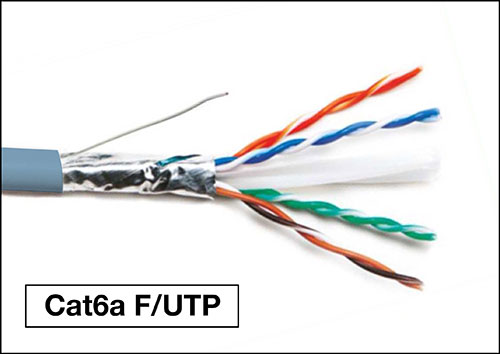Shielded Cat6a Cables – F/UTP vs U/FTP - Which One Should I Use?
CAT6A (Category 6 Augmented) is becoming the cable of choice for structured cable networks and distribution of HD signals over twisted pair cables. CAT6a allows the transmission of high frequency 500Mhz signals up to 10Gbps. CAT6A 10GBASE-T standards are specified in ANSI/TIA 569.C-2 and ISO/IEC 11801 Class Ea.
As a result of the higher frequencies utilized by 10GBASE-T, CAT6A cables are more sensitive to performance and environmental factors than Cat6 or Cat5e cables.
Because of these same factors, shielded Category 6A (Cat6 Augmented) cable is typically the recommended 10G cable for most installations. Shielded Cat6a is the dominant infrastructure cable in Europe and many international markets. In the USA however, unshielded Cat6a remains dominant over the shielded versions. The choice of shielded versus unshielded leads to passionate debates amongst installers and project specifiers. The ultimate choice comes down to the type of installation, environmental factors, and of course budgetary constraints.
Shielded Cat6a Construction Types on the Market
There are several different construction types of Cat6a that are popular in the market today. They include: F/UTP, U/FTP, F/FTP and S/FTP. For the purposes of this discussion, we will focus on 2 versions: F/UTP versus U/FTP.
Basic F/UTP construction consists of (4) 23awg unshielded twisted pair wires surrounded by an overall AL Foil Shield. There is also a center spline (or cross member) that separates each pair. This is the same typical construction type used for Cat6 and Cat5e STP cables. [Note: The center spline/pair separator is used on UTP Cat6a and Cat6 cables.]
Basic U/FTP construction consists of each wire pair surrounded by its own AL Foil Shield. There is no center spline needed.
However, just as in life, the “devil is in the details.” There are significantly more differences between F/UTP and U/FTP, both in the cable construction and cable performance that is not readily noticeable. Cat6a U/FTP is superior in performance, easier to terminate, and easier to install than F/UTP.
U/FTP has smaller Overall Diameter
Because U/FTP cable does not require a center spline separating the wire pairs to maintain pair geometry, the cable overall diameter (OD) is much smaller than F/UTP cables. Without the center spline, the U/FTP cable is more flexible and easier to work with during installation. It also takes up less room in the conduit than the F/UTP.
U/FTP is easier to Terminate
In F/UTP cables the NEXT loss and FEXT loss (crosstalk between the pairs) is controlled by the twists or lay-length. Due to crosstalk coupling, higher frequencies require twisted pairs in shorter lay lengths or twists, with each pair having a different twist from the other. In U/FTP cables the NEXT loss and FEXT loss are primarily controlled by the individual foil shields. As a result, the twists or lay lengths can be longer or looser with each pair similar to the other. The benefits of looser twists or longer lay lengths is lower DC resistance per cable length and easier to untwist for termination. The lower DC resistance is also important for better PoE/PoH support. [PoE stands for Power over Ethernet and PoH stands for Power over HDBaseT.]
U/FTP Cable has Lower Delay Skew than F/UTP
Because U/FTP cables have similar lay lengths/twists, the propagation delay skew is very small. Lower delay skews provide higher margins which minimizes the amount of re-transmission of the data and maximizes the data rate.
U/FTP Cables Provide Better PoE/PoH Support
As stated above, because U/FTP cables have looser twists with longer lay lengths, this lowers the DC resistance on the cable. This is important for PoE/PoH. Also, the individual foil shields provide better heat dissipation which is critical for PoE/PoH support. The shields minimize temperature increases experienced with PoE/PoH.
U/FTP Cables Provide Better Performance
The individual foil shields on each pair improves the overall cable performance as compared to a F/UTP shielded cable. The AL foils minimize crosstalk between the pairs. With F/UTP cables, crosstalk is actually increased because the signal is reflected off the overall foil shield inside the cable, negatively affecting cable performance. This results in significantly lower NEXT and ACR-F margins with F/UTP vs U/FTP. [This means significantly higher NEXT loss and FEXT loss.]
Additionally, U/FTP Cat6a cables use a Foam PE insulation on the wire conductors while the F/UTP uses the typical solid PE insulation. F/UTP cables have to use solid insulation to avoid deformation of the insulation during the tighter wire twists (shorter lay) twinning process. The cellular insulation (FPE) used with U/FTP Cat6a has a lower dielectric constant resulting in a higher velocity of propagation; and lower dielectric losses resulting in lower attenuation than F/UTP.
Summary
SCP does not recommend using F/UTP shielded Cat6a cables for any installation. If using Shielded Cat6a cables, we recommend using U/FTP (or F/FTP, S/FTP depending on the installation) as the standard shielded Cat6a cable for most 10G installations. Also, we would recommend using UTP Cat6a before you used F/UTP Cat6a because F/UTP can actually lower the cable performance irrespective of any outside EMI issues. If you are certifying a 10GBASE-T system, we strongly recommend not using F/UTP cables.
Here is a recap of the benefits of U/FTP Cat6a versus F/UTP construction:
1. U/FTP has smaller cable OD
2. U/FTP is more flexible and easier to work with
3. U/FTP is better for HDBaseT
4. U/FTP is easier and faster to terminate because there is no center spline and the wire pairs are twisted looser
5. U/FTP provides better PoE/PoH support because it has lower DC resistance and better heat dissipation.
6. U/FTP has lower delay skew
7. U/FTP provides higher NEXT and ACR-F headroom margins
8. U/FTP has higher velocity of propagation and lower attenuation because of the Foam PE insulation used
Download here our pdf : Shielded Cat6a Cables – U/FTP vs F/UTP – Which One Should I Use?



